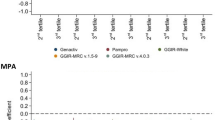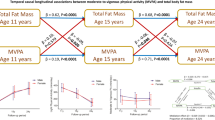Abstract
Background:
The impact of accelerometer-related methodological decisions relating to the assessment of physical activity and sedentary time has not been conclusively determined in young children.
Objectives:
To determine the effects of epoch and cutoff points on the assessment of physical activity and sedentary time and to determine the accelerometer wear time required to achieve reliable accelerometer data in children.
Design:
Children were recruited from centres at Ghent, Glasgow, Gothenburg and Zaragoza.
Methods:
Physical activity was assessed for 1 week in 86 children (41 girls, 45 boys; mean age 7±2 years) by uniaxial accelerometry. The epoch was set at 15 s and reintegrated to 30 and 60 s. Time spent sedentary and in moderate and vigorous physical activity (MVPA) was assessed using a range of cutoff points. Number of days required to achieve 80% reliability was predicted using the Spearman–Brown Prophecy formula.
Results:
The Reilly cutoff points (<1100 counts per min (CPM)) indicated less sedentary time per day when comparing 15 vs 30 s and 15 vs 60 s epochs: 570±91 vs 579±93 min and 570±91 vs 579±94 min, respectively; P<0.05. Pate cutoff points (>420 counts per 15 s) reported more MVPA time per day compared with Sirard (890 counts per 15 s) and Puyau cutoff points (>3200 counts per min) using 15 s epoch: 78 (4–197) min (median (range) vs 18 (1–80) min and 24 (1–100) min, respectively; P<0.001. Compliance with guidelines of at least 60 min MVPA was 84, 78 and 73% for Pate cutoff points using 15, 30 and 60 s epochs, respectively, but 0% for Sirard and Puyau cutoff points across epochs. The number of days required to achieve 80% reliability for CPM, sedentary and MVPA time was 7.4–8.5 days.
Conclusion:
Choice of epoch and cutoff point significantly influenced the classification of sedentary and MVPA time and observed compliance to the MVPA guidelines.
This is a preview of subscription content, access via your institution
Access options
Subscribe to this journal
Receive 12 print issues and online access
$259.00 per year
only $21.58 per issue
Buy this article
- Purchase on Springer Link
- Instant access to full article PDF
Prices may be subject to local taxes which are calculated during checkout
Similar content being viewed by others
References
Jackson-Leach R, Lobstein T . Estimated burden of paediatric obesity and co-morbidities in Europe. Part 1. The increase in the prevalence of child obesity in Europe is itself increasing. Int J Paed Obes 2006; 1: 26–32.
Bammann K, Peplies J, Sjöström M, Lissner L, De Henauw S, Galli C et al. Assessment of diet, physical activity and biological, social and environmental factors in a multi-centre European project on diet- and lifestyle-related disorders in children (IDEFICS). J Pub Health 2006; 14: 279–289.
Reilly JJ . Physical activity, sedentary behaviour and energy balance in the preschool child: Opportunities for early obesity prevention. Proc Nutr Soc 2008; 67: 317–325.
Trost SG . State of the art reviews: measurement of physical activity in children and adolescents. Am J lifestyle Med 2007; 1: 299–314.
Stone MR, Rowlands AV, Eston RG . Relationships between accelerometer-assessed physical activity and health in children: impact of the activity-intensity classification method. J Sports Sci Med 2009; 8: 136–143.
Rowlands AV, Eston RG . The measurement and interpretation of children's physical activity. J Sports Sci Med 2007; 6: 270–276.
Guinhoya CB, Hubert H, Soubrier S, Vilhelm C, Lemdani M, Durocher A . Moderate-to-vigorous physical activity among children: discrepancies in accelerometer based cut-points. Obes 2006; 14: 774–777.
Reilly JJ, Penpraze V, Hislop J, Davies G, Grant S, Paton JY . Objective measurement of physical activity and sedentary behavior: review with new data. Arch Dis Child 2008; 93: 614–619.
Corder K, Ekelund U, Steele R, Wareham N, Brage S . Assessment of physical activity in youth. J Appl Physiol 2008; 105: 977–987.
McClain JJ, Abraham TL, Brusseau TA, Tudor-Locke C . Epoch length and accelerometer outputs in children: comparison to direct observation. Med Sci Sports Exerc 2008; 40: 2080–2087.
Edwardson CL, Gorely T . Epoch length and its effect on physical activity intensity. Med Sci Sports Exerc 2010; 42: 928–934.
Dorsey K, Herrin J, Krumholz H, Irwin M . The utility of shorter epochs in direct motion monitoring. Res Q Exerc Sport 2009; 80: 460–468.
Penpraze V, Reilly JJ, Montgomery C, Kelly L, Paton J, Grant S . Effect of accelerometer cut-points on apparent levels of physical activity and inactivity in young children. Med Sci Sports Exerc 2006; 38: S565.
Rowlands AV, Powell SM, Humphries R, Eston RG . The effect of accelerometer epoch on physical activity output measures. J Exerc Sci Fit 2006; 4: 52–58.
Nilsson A, Ekeland U, Yngve A, Sjostron M . Assessing physical activity among children with accelerometers using different time sampling intervals and placements. PES 2002; 14: 87–96.
Penpraze V, Reilly JJ, MacLean CM, Montgomery C, Kelly LA, Paton JY et al. Monitoring of physical activity in young children: how much is enough? Pediatr Exerc Sci 2006; 18: 483–491.
Trost SG, Pate RR, Freedson PS, Sallis JF, Taylor WC . Using objective physical activity measures with youth: how many days of monitoring needed? Med Sci Sports Exerc 2000; 32: 426–431.
Treuth M, Sherwood NE, Butte NF, McClanahan B, Obarzanek E, Zhou A et al. Validity and reliability of activity measures in African-American girls for GEMS. Med Sci Sports Exerc 2003; 35: 532–539.
Sirard JR, Trost SG, Pfeiffer KA, Dowda M, Pate RR . Calibration and evaluation of an objective measure of physical activity. J Phys Activity Health 2005; 2: 345–357.
Reilly JJ, Coyle J, Kelly L, Burke G, Grant S, Paton JY . An objective method for measurement of sedentary behaviour in 3- to 4-year olds. Obes Res 2003; 11: 1155–1158.
Puyau MR, Adolph AL, Firoz AV, Butte NF . Validation and calibration of physical activity monitors in children. Obes Res 2002; 10: 150–157.
Pate RR, Almeida MJ, McIver LK, Pfeiffer KA, Dowda M . Validation and calibration of an accelerometer in preschool children. Obes 2006; 14: 2000–2006.
Cavill N, Biddle S, Sallis JF . Health enhancing physical activity for young people: statement of the United Kingdom expert consensus conference. PES 2001; 13: 12–25.
Olds T, Ridley K, Wake M, Hesketh K, Waters E, Patton G et al. How should activity guidelines for young people be operationalised?. http://www.ijbnpa.org/content/4/1/43.
Trost S, McIver K, Pate R . Conducting accelerometer-based activity assessment in field-based research. Med Sci Sports Exerc 2005; 37: S531–S543.
Masse LC, Fuemmeler BF, Anderson CB, Matthews CE, Trost SG, Catellier DJ et al. Accelerometer data reduction: a comparison of four reduction algorithms on select outcome variables. Med Sci Sports Exerc 2005; 37: S544–S554.
Baranowski T, De Moor C . How many days was that? Intra-individual variability and physical activity assessment. Res Q Exerc Sport 2000; 71: 74–78.
Ridley K, Olds T, Hands B, Larkin D, Parker H . Intra-individual variation in children's physical activity patterns: implications for measurement. J Sci Med Sport 2009; 12: 568–572.
Roberts DE, Freedson PS . Accuracy of accelerometer count cut-points in children. Med Sci Sports Exerc 2007; 39: S179–S180.
Acknowledgements
We thank all members of the validation study and especially the children and their parents for their enthusiastic participation in the study. This study was conducted as part of the IDEFICS study and is published on behalf of its European Consortium (http://www.idefics.eu). We gratefully acknowledge the financial support of the European Community within the Sixth RTD Framework Programme Contract No. 016181 (FOOD).
The information in this document reflects the author's view and is provided as it is.
Author information
Authors and Affiliations
Consortia
Corresponding author
Ethics declarations
Competing interests
The authors declare no conflict of interest.
Additional information
Statement of ethics
We certify that all applicable institutional and governmental regulations pertaining to the ethical use of human volunteers were followed during this research. Approval by the appropriate ethics committees was obtained by each of the eight centres engaged in the fieldwork. Participants were not subjected to any procedure before both the children and their parents gave consent for examinations, collection of samples, subsequent analysis and storage of personal data and collected samples. The participating children and their parents could consent to single components of the study while refraining from others.
Rights and permissions
About this article
Cite this article
Ojiambo, R., Cuthill, R., Budd, H. et al. Impact of methodological decisions on accelerometer outcome variables in young children. Int J Obes 35 (Suppl 1), S98–S103 (2011). https://doi.org/10.1038/ijo.2011.40
Published:
Issue Date:
DOI: https://doi.org/10.1038/ijo.2011.40
Keywords
This article is cited by
-
Prospective associations between changes in physical activity and sedentary time and subsequent lean muscle mass in older English adults: the EPIC-Norfolk cohort study
International Journal of Behavioral Nutrition and Physical Activity (2024)
-
Associations between change in physical activity and sedentary time and health-related quality of life in older english adults: the EPIC-Norfolk cohort study
Health and Quality of Life Outcomes (2023)
-
A systematic review of the validity, reliability, and feasibility of measurement tools used to assess the physical activity and sedentary behaviour of pre-school aged children
International Journal of Behavioral Nutrition and Physical Activity (2021)
-
Trajectories of objectively measured physical activity and childhood overweight: longitudinal analysis of the IDEFICS/I.Family cohort
International Journal of Behavioral Nutrition and Physical Activity (2021)
-
No one accelerometer-based physical activity data collection protocol can fit all research questions
BMC Medical Research Methodology (2020)



